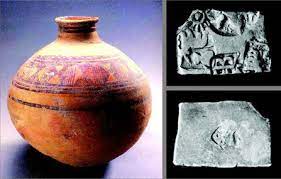
Chapter-1
1.1 Rasheeda’s Curiosity:
The chapter commences with Rasheeda, an inquisitive reader, who stumbles upon a captivating headline, “One Hundred Years Ago,” within the pages of a newspaper. This sparks her pondering on the seemingly insurmountable challenge of unraveling events from such a distant past.
1.2 Discovering the Past:
A comprehensive exploration unfolds, detailing the diverse methods employed to uncover historical narratives. From the relatively recent past, where radio, television, and newspapers serve as tangible sources, to the complexities associated with understanding epochs long gone by, the chapter sets the stage for an intriguing journey through time.
1.3 What Can We Know About the Past? The narrative then delves into the multifaceted aspects of daily life that act as windows into historical societies. From the intricacies of culinary preferences and clothing choices to the spectrum of occupations such as hunting, farming, and more, readers are introduced to the diverse tapestry of ancient civilizations.
1.4 Geographical Significance: Geographical locations emerge as key protagonists in this historical narrative. Specific regions, such as the banks of the Narmada River, Sulaiman and Kirthar hills, Garo hills, Vindhyas, and river systems like Indus and Ganga, are highlighted for their pivotal roles in shaping the course of history.

1.5 Movement of People: The chapter accentuates the dynamic movement of people across the vast subcontinent. Despite natural barriers such as mountains and seas, individuals traversed the landscape, contributing to the enrichment of cultural traditions and fostering the exchange of ideas.
1.6 Names of the Land: Intriguingly, the chapter explores the etymology of the terms “India” and “Bharat,” revealing their origins in historical interactions with Iranians and Greeks. This linguistic journey takes readers back to a time when the region was referred to as Hindos or Indos.
1.7 Methods of Discovering the Past: A comprehensive exploration of methodologies ensues, introducing manuscripts, inscriptions, and archaeological studies as invaluable tools for historians and archaeologists. The discussion unfolds the nuances of these sources, ranging from handwritten manuscripts on palm leaves to inscriptions on stone or metal.
1.8 Our Pasts – Diversity in Experiences: The chapter introduces the intriguing concept of “Our Pasts” in the plural, underscoring the diverse experiences among different societal groups. From the lives of herders and farmers to rulers, merchants, and craftspersons, the historical narrative is painted with strokes of diversity.

1.9 Understanding Dates: Demystifying the intricacies of historical dating systems, the chapter elucidates the usage of BC (Before Christ), AD (Anno Domini), CE (Common Era), BCE (Before Common Era), and BP (Before Present). These chronological markers serve as temporal signposts, aiding in the navigation of historical timelines.
1.10 Conclusion: The chapter culminates by summarizing the foundational concepts introduced, setting the stage for a continued exploration into the realms of historical inquiry and the interconnectedness of diverse societies through shared history